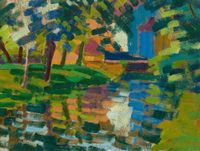Auguste Herbin, issu d'une famille d'ouvriers tisseurs, naît le 29 avril 1882 dans un petit village près de la frontière belge.
Read MoreA partir de 1900, l'artiste étudie à l'Ecole des Beaux-Arts de Lille avant de s'installer à Paris où il rejoint tout d'abord les impressionnistes puis les Fauves.
Auguste Herbin, voisin d'atelier de Braque et de Picasso, étudie également le cubisme dont l'influence l'incite à créer ses premières toiles cubistes dès 1913. Ses travaux aboutissent à une phase géométrique non-figurative à partir de 1917, cette dernière évoluant de manière croissante vers le constructivisme à l'exception d'une interruption en 1922 alors que le peintre revient brièvement à une manière de peindre figurative.
En 1929, Auguste Herbin devient co-fondateur du 'Salon des Surindépendants' et initie deux ans plus tard l'association d'artistes 'Abstraction-Création' avec l'aide de Vantongerloo entre autres, avec lequel il édite l'almanach du groupe jusqu'en 1937.
A la fin de la guerre, Auguste Herbin est co-fondateur et vice-président et devient finalement président du 'Salon des Réalités Nouvelles' à partir de 1955. L'étude du Trecento italien incite Herbin à se consacrer à la peinture concrète composée de formes géométriques simples avec des aplats de couleurs pures dès 1938. L'artiste conçoit en 1946 l''alphabet plastique', un système de composition reposant sur la structure des lettres et qui constitue le fondement de l'organisation de ses toiles. Dans son ouvrage 'L'art non-figuratif non-objectif', paru en 1949, Herbin présente cet aspect ainsi que ses théories des couleurs inspirées en partie par la théorie des couleurs de Goethe.
En raison d'une hémiplégie, Herbin doit apprendre dès 1953 à peindre de la main gauche. Les idées architectoniques caractéristiques de l'œuvre d'Herbin et ses qualités de coloriste permettent à l'artiste de jouir déjà d'une forte renommée au niveau international aussi bien pendant la période d'avant-guerre que par la suite.
ntre 1955 et 1972, les œuvres d'Auguste Herbin sont exposées à la documenta I, II et V de la ville de Cassel. L'artiste est représenté à New York lors d'une exposition importante au musée Guggenheim en 1979. D'autres travaux sont montrés en 1987 à Düsseldorf dans la collection d'objets d'art de Rhénanie du Nord - Westphalie dans le cadre de l'exposition 'Positions de l'art indépendant en Europe vers 1937'. Auguste Herbin meurt le 31 janvier 1960 à Paris. Suite à sa disparition subite, une toile reste inachevée et porte le titre 'Fin'
Text courtesy galerie denise rené.




